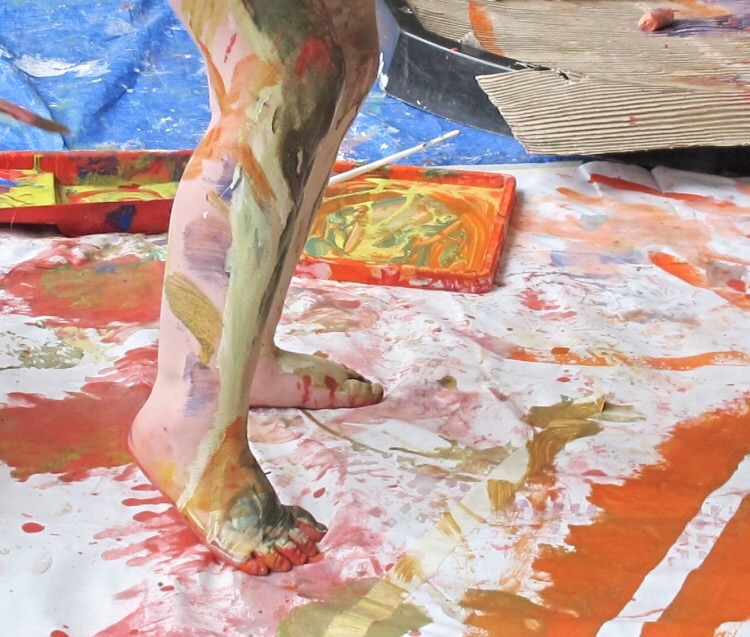This post looks at ‘demonstrating’ as a way of supporting children’s creative learning with art. Demonstrating skills and techniques are an important part in opening up new possibilities for children’s experimentation with materials.
This post is the third post in a series on techniques for facilitating children’s learning with art.
- The first introduced the idea of facilitating learning.
- The second looked at ‘suggestions’ as a technique for facilitating learning.
- The third discussed the technique of ‘questioning.’
Each post includes a description of the technique for facilitating children’s learning with art as well as discussion on how and when it may be useful. These techniques should not be seen as all-conclusive methods of teaching but as options that can be experimented with.
What is demonstrating?
To demonstrate means to show or explain how something is done (Cambridge Dictionary online, 2017). Demonstrating can be used to assist children in learning alternative and more effective ways of exploring a problem (MacNaughton & Williams 2009). Demonstrating can be done to introduce both verbal and non-verbal skills to children. These skills may then help them to be more independent in their learning. Examples of demonstrations may include an educator:
- Pronouncing a new vocabulary word;
- Showing how to use a new art tool;
- Demonstrating how to use Google to do an online search.
Making a decision about when to intervene in children’s learning to demonstrate a new skill or technique can be difficult. It may be necessary for an educator to first assess a child’s current understanding in the zone of proximal development before introducing a new skill to extend this (Vygotsky, 1980).

Why is demonstrating important in children’s learning with art?
Demonstrating opens up new possibilities for children’s further experimentation and learning.
An artist or art educator may be able to share their specialised knowledge of tools, art techniques and concepts by demonstrating. If these skills are not passed on, what child can and cannot do with an art material is limited by what they currently know and don’t know. As Bolt & McArdle (2013: 14) state:
“With mantras, then, of self-expression, freedom and creativity, art teachers may avoid providing much direct instruction about art making to children, all the while having ‘rules for breaking the rules’ and to ‘teach without teaching’ (McArdle, 2008: 367) which go unspoken and taken for granted. Many preservice teachers, having themselves been left in primary and secondary school to develop ‘naturally’, give the lie to this notion of ‘natural unfolding’, when they arrive at university with little or no skill or artistry and without artistic language or insight. The discourse of ‘natural unfolding’ is attractive to those who know nothing about art, and it is convenient in the contemporary era of bare-bones educational funding. If there is no teaching to be done in the arts, then there is no need for an art teacher.’
The demonstration of specific artistic skills and techniques is therefore an important part in extending children’s learning over time.
Demonstrating a skill does not necessarily mean that a child will choose to use that particular skill or technique in the future. Rather, demonstrating gives children the opportunity to investigate it, opening up new possibilities for creative learning.
It is fair to say that while demonstrating does somewhat require a child to imitate an action or behaviour, it does not necessarily produce a singular way for them to leave.
For example…
Imagine this…
A four-year-old girl walks into a family art activity in a sculpture garden. The activity features an array of natural materials laid out over the lawn. The child runs over to the materials and begins stacking branches onto of one another. After a period of time, the facilitator decides to introduce a new material – clay- to the child. The facilitator sits beside the child and rolls large chunks of the clay in her hands. She places it on the clay on the ground then pushes the branches into it. The girl watches the non-verbal demonstration. After a while, the child begins to play with the clay too. She mimics the facilitator’s action, sticking the branches into the clay to make a sculpture. Even if the girl had totally ignored the artist’s demonstration, the action opened up new possibilities for the child’s experimentation and play with the natural materials.
Hot tips for using demonstrations to support children’s learning with art
- Create a sequential set of steps that break down for the skill can be performed. Practice this set of steps in advance as it will be much easier to demonstrate the skill to children if you are confident in performing the skill in advance;
- Start simple by introducing the most basic version of the skill to the children first. Once they have mastered this version, you could then introduce more complex versions of the skill over time;
- If you are giving a verbal demonstration, try using clear, direct language to support the demonstration (MacNaughton & Williams, 2009);
- Allow children lots of time to practice the skill. Encourage them to ask questions about it and discuss it as a group;
- Encourage children to experiment with the skill or technique in different situations once they feel comfortable performing it;
- Try to give further suggestions to children on how the skill could be used with other techniques, materials and concepts.
I hope you find these tips and techniques helpful.
As always, I would love to know your thoughts so please leave your comments below.
References
Bolt & McArdle (2013). ‘Young Children, pedagogy and the arts: Ways of seeing.’ In McArdle & Boldt (Eds). Young children, pedagogy and the arts. Routledge: New York.
Cambridge Dictionary online (2017). Cambridge Dictionary website. Cambridge University Press.
MacNaughton, G & Williams, G (2009). Teaching young children: Choices in theory and practice. Second edition. Maidenhead: Open University Press.
Vygotsky, L (1980). Mind in society: The development of higher psychological processes. Cambridge, MA: Harvard University Press.
Related posts
Creativity and multiculturalism in children’s learning – an interview with Lorna Rose
What does it mean to facilitate children’s learning?
How to support children’s creativity with materials. A post for parents!




4 Comments
Great read Louisa. Demonstrating is akin to lending a child a skill, by playing and experimenting with materials alongside. It is about sharing ideas, techniques and vocabulary, about commenting on processes, listening, revisiting and extending. An intimate sharing between learners.
Hi, I have benefited a lot from reading this post of yours. I have such a useful site, you can see if you want.
https://www.youtube.com/watch?v=wQUmbAMO1RY&t=2s
Pingback: How Does Your Child Demonstrate Enthusiasm For Learning? – Fallsgardencafe
Pingback: What Are The Characteristics Of A Good Demonstration? – Fallsgardencafe